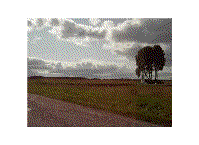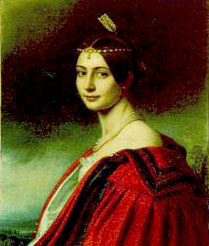|
Vshchizh
Vshchizh (russian: Вщиж) is a village in the Zhukovka rayon of the Bryansk Oblast of Russia. Now it is a part of the Shamordino rural settlement. Vshchizh was an old Russian town on the Desna River between the 11th and 13th centuries. It was first mentioned in a chronicle of 1142. In the mid-12th century, it was an appanage town of Prince Svyatoslav Vladimirovich. In 1238, Vshchizh was destroyed by the Mongols. Later, Vshchizh was reborn as a village that exists to this day. As a result of the excavations in the 1840s and then in 1940 and 1948–1949 (by a Soviet archaeologist Boris Rybakov), the remnants of different buildings and fortification A fortification is a military construction or building designed for the defense of territories in warfare, and is also used to establish rule in a region during peacetime. The term is derived from Latin ''fortis'' ("strong") and ''facere' ...s and a number of artifacts were found. This quiet spot has been Fyodo ... [...More Info...] [...Related Items...] OR: [Wikipedia] [Google] [Baidu] |
Vchig Animated
Vshchizh (russian: Вщиж) is a village in the Zhukovka rayon of the Bryansk Oblast of Russia. Now it is a part of the Shamordino rural settlement. Vshchizh was an old Russian town on the Desna River between the 11th and 13th centuries. It was first mentioned in a chronicle of 1142. In the mid-12th century, it was an appanage town of Prince Svyatoslav Vladimirovich. In 1238, Vshchizh was destroyed by the Mongols. Later, Vshchizh was reborn as a village that exists to this day. As a result of the excavations in the 1840s and then in 1940 and 1948–1949 (by a Soviet archaeologist Boris Rybakov), the remnants of different buildings and fortifications and a number of artifacts were found. This quiet spot has been Fyodor Tyutchev Fyodor Ivanovich Tyutchev ( rus, Фёдор Ива́нович Тю́тчев, r=Fyódor Ivánovič Tyútčev, links=1, p=ˈfʲɵdər ɪˈvanəvʲɪt͡ɕ ˈtʲʉt͡ɕːɪf; Pre-Reform orthography: ; – ) was a Russian poet and diploma ... [...More Info...] [...Related Items...] OR: [Wikipedia] [Google] [Baidu] |
Mongols
The Mongols ( mn, Монголчууд, , , ; ; russian: Монголы) are an East Asian ethnic group native to Mongolia, Inner Mongolia in China and the Buryatia Republic of the Russian Federation. The Mongols are the principal member of the large family of Mongolic peoples. The Oirats in Western Mongolia as well as the Buryats and Kalmyks of Russia are classified either as distinct ethno-linguistic groups or subgroups of Mongols. The Mongols are bound together by a common heritage and ethnic identity. Their indigenous dialects are collectively known as the Mongolian language. The ancestors of the modern-day Mongols are referred to as Proto-Mongols. Definition Broadly defined, the term includes the Mongols proper (also known as the Khalkha Mongols), Buryats, Oirats, the Kalmyk people and the Southern Mongols. The latter comprises the Abaga Mongols, Abaganar, Aohans, Baarins, Chahars, Eastern Dorbets, Gorlos Mongols, Jalaids, Jaruud, Kharchins, Khishig ... [...More Info...] [...Related Items...] OR: [Wikipedia] [Google] [Baidu] |
Rural Localities In Zhukovsky District, Bryansk Oblast
In general, a rural area or a countryside is a geographic area that is located outside towns and cities. Typical rural areas have a low population density and small settlements. Agricultural areas and areas with forestry typically are described as rural. Different countries have varying definitions of ''rural'' for statistical and administrative purposes. In rural areas, because of their unique economic and social dynamics, and relationship to land-based industry such as agriculture, forestry and resource extraction, the economics are very different from cities and can be subject to boom and bust cycles and vulnerability to extreme weather or natural disasters, such as droughts. These dynamics alongside larger economic forces encouraging to urbanization have led to significant demographic declines, called rural flight, where economic incentives encourage younger populations to go to cities for education and access to jobs, leaving older, less educated and less wealthy populati ... [...More Info...] [...Related Items...] OR: [Wikipedia] [Google] [Baidu] |
Defunct Towns In Russia
{{Disambiguation ...
Defunct (no longer in use or active) may refer to: * ''Defunct'' (video game), 2014 * Zombie process or defunct process, in Unix-like operating systems See also * * :Former entities * End-of-life product * Obsolescence Obsolescence is the state of being which occurs when an object, service, or practice is no longer maintained or required even though it may still be in good working order. It usually happens when something that is more efficient or less risky r ... [...More Info...] [...Related Items...] OR: [Wikipedia] [Google] [Baidu] |
Destroyed Towns
*
{{disambiguation ...
Destroyed may refer to: * ''Destroyed'' (Sloppy Seconds album), a 1989 album by Sloppy Seconds * ''Destroyed'' (Moby album), a 2011 album by Moby See also * Destruction (other) * Ruined (other) Ruins are the remains of man-made architecture. Ruins or ruin may refer to: History *The Ruin (Ukrainian history), a period in Ukrainian history after the death of Bohdan Khmelnytsky in 1657 Geography *Ruin, Iran, a village in North Khorasan Pr ... [...More Info...] [...Related Items...] OR: [Wikipedia] [Google] [Baidu] |
Fyodor Tyutchev
Fyodor Ivanovich Tyutchev ( rus, Фёдор Ива́нович Тю́тчев, r=Fyódor Ivánovič Tyútčev, links=1, p=ˈfʲɵdər ɪˈvanəvʲɪt͡ɕ ˈtʲʉt͡ɕːɪf; Pre-Reform orthography: ; – ) was a Russian poet and diplomat. Life Tyutchev was born into a Russian noble family in the Ovstug family estate near Bryansk (modern-day Zhukovsky District, Bryansk Oblast of Russia). His father Ivan Nikolaevich Tyutchev (1768—1846) was a court councillor who served in the Kremlin Expedition that managed all building and restoration works of Moscow palaces. One of Ivan's sister (1774—1837), was a hegumenia famous for founding the Borisoglebsky Anosin Women's Monastery.'' Ivan Aksakov (1997)''. Fyodor Ivanovich Tyutchev's Biography. — Moscow: AO Book and Business, p. 172-173 ''Gennady Chagin (2004)''. Fyodor Ivanovich Tyutchev. — Moscow: Russkiy mir, p. 17 The Tyutchevs traced their roots to Zakhariy Tutchev mentioned in ''The Tale of the Rout of Mamai'', a 1 ... [...More Info...] [...Related Items...] OR: [Wikipedia] [Google] [Baidu] |
Artifact (archaeology)
An artifact, or artefact (see American and British English spelling differences), is a general term for an item made or given shape by humans, such as a tool or a work of art, especially an object of archaeological interest. In archaeology, the word has become a term of particular nuance and is defined as an object recovered by archaeological endeavor, which may be a cultural artifact having cultural interest. Artifact is the general term used in archaeology, while in museums the equivalent general term is normally "object", and in art history perhaps artwork or a more specific term such as "carving". The same item may be called all or any of these in different contexts, and more specific terms will be used when talking about individual objects, or groups of similar ones. Artifacts exist in many different forms and can sometimes be confused with ecofacts and features; all three of these can sometimes be found together at archaeological sites. They can also exist in different t ... [...More Info...] [...Related Items...] OR: [Wikipedia] [Google] [Baidu] |
Fortification
A fortification is a military construction or building designed for the defense of territories in warfare, and is also used to establish rule in a region during peacetime. The term is derived from Latin ''fortis'' ("strong") and ''facere'' ("to make"). From very early history to modern times, defensive walls have often been necessary for cities to survive in an ever-changing world of invasion and conquest. Some settlements in the Indus Valley civilization were the first small cities to be fortified. In ancient Greece, large stone walls had been built in Mycenaean Greece, such as the ancient site of Mycenae (famous for the huge stone blocks of its 'cyclopean' walls). A Greek '' phrourion'' was a fortified collection of buildings used as a military garrison, and is the equivalent of the Roman castellum or English fortress. These constructions mainly served the purpose of a watch tower, to guard certain roads, passes, and borders. Though smaller than a real fortress, they act ... [...More Info...] [...Related Items...] OR: [Wikipedia] [Google] [Baidu] |
Boris Rybakov
Boris Alexandrovich Rybakov (Russian language, Russian: Бори́с Алекса́ндрович Рыбако́в, 3 June 1908, Moscow – 27 December 2001) was a Soviet Union, Soviet and Russian historian who personified the anti-Normanist theory, Normanist vision of Russian history. He is the father of Indologist Rostislav Rybakov. Life and works Rybakov held a chair in Russian history at the Moscow University since 1939, was a deputy dean of the university in 1952–54, and administered the Russian History Institute more than 40 years. In 1954, Rybakov and Andrey Kursanov represented the Soviet Academy of Sciences at the Columbia University Bicentennial in New York City. His first groundbreaking monograph was the ''Handicrafts of Ancient Rus'' (1948), which sought to demonstrate the economic superiority of Kievan Rus to contemporary Western Europe. Rybakov led important excavations in Moscow, Novgorod, Zvenigorod, Chernigov, Pereyaslav, Tmutarakan and Putivl and publishe ... [...More Info...] [...Related Items...] OR: [Wikipedia] [Google] [Baidu] |
Excavation (archaeology)
In archaeology, excavation is the exposure, processing and recording of archaeological remains. An excavation site or "dig" is the area being studied. These locations range from one to several areas at a time during a project and can be conducted over a few weeks to several years. Excavation involves the recovery of several types of data from a site. This data includes artifacts (portable objects made or modified by humans), features (non-portable modifications to the site itself such as post molds, burials, and hearths), ecofacts (evidence of human activity through organic remains such as animal bones, pollen, or charcoal), and archaeological context (relationships among the other types of data).Kelly&Thomas (2011). ''Archaeology: down to earth'' (4th ed.). Belmont, Calif.: Wadsworth, Cengage Learning. Before excavating, the presence or absence of archaeological remains can often be suggested by, non-intrusive remote sensing, such as ground-penetrating radar. Basic informat ... [...More Info...] [...Related Items...] OR: [Wikipedia] [Google] [Baidu] |
Svyatoslav Vladimirovich
Sviatoslav (russian: Святосла́в, Svjatosláv, ; uk, Святосла́в, Svjatosláv, ) is a Russian and Ukrainian given name of Slavic origin. Cognates include Svetoslav, Svatoslav, , Svetislav. It has a Pre-Christian pagan character and means "one who worships the light" (likely in reference to the sun). In Christian times the name's meaning started to be associated with the Proto-Slavic roots (holy) and (glory), to be explained as "One who worships the Holy". A diminutive form for Sviatoslav is Svetlyo (Bulgarian), Slava (Russian), (Polish), Slavik (Ukrainian). Its feminine form is Sviatoslava. The name may refer to: People Monarchs *Sviatoslav I of Kiev (c. 942 – 972), emperor of Rus *Sviatoslav II of Kiev (1027–1076), prince of Kiev and Chernigov *Sviatoslav III of Kiev (before 1141–1194), prince of Turov (1142 and 1154), Vladimir and Volyn (1141–1146), Pinsk (1154), Novgorod-Seversky (1157–1164), Chernigov (1164–1177), Grand Prince of Kiev (1174 ... [...More Info...] [...Related Items...] OR: [Wikipedia] [Google] [Baidu] |
Road To Vshchizh
A road is a linear way for the conveyance of traffic that mostly has an improved surface for use by vehicles (motorized and non-motorized) and pedestrians. Unlike streets, the main function of roads is transportation. There are many types of roads, including parkways, avenues, controlled-access highways (freeways, motorways, and expressways), tollways, interstates, highways, thoroughfares, and local roads. The primary features of roads include lanes, sidewalks (pavement), roadways (carriageways), medians, shoulders, verges, bike paths (cycle paths), and shared-use paths. Definitions Historically many roads were simply recognizable routes without any formal construction or some maintenance. The Organization for Economic Co-operation and Development (OECD) defines a road as "a line of communication (travelled way) using a stabilized base other than rails or air strips open to public traffic, primarily for the use of road motor vehicles running on their own wheels", which i ... [...More Info...] [...Related Items...] OR: [Wikipedia] [Google] [Baidu] |








